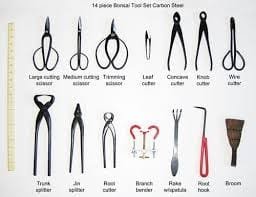When you’re growing bonsai trees, it’s crucial to use the right tools and equipment. By doing so, you’re able to execute bonsai cleaning, training, and styling accurately. If you’re a newbie, choose a few necessary tools, such as a standard shear and a good quality concave cutter.
Once you work further and advance your knowledge on growing bonsai, you can invest in specialized tools, such as Japanese Bonsai tools, later on.
In this post, you’ll learn the best Japanese bonsai tools so you can choose the right ones to pursue your passion.
Importance of Using Japanese Bonsai Tools
Japanese Bonsai tools are made of high-quality materials and craftsmanship. Also, they’re known for their high prices, as compensated by the quality of work.
On the other hand, Chinese tools are becoming in-demand like Japanese bonsai tools because of the increasing quality of materials and affordable prices. But generally, Japanese bonsai tools still perform better.
Regardless of your choice, find the best one considering the durability, function, and overall quality.

Image Credit: Amazon
Here are the Best Japanese Tools:
Cutting Tools
You’ll most likely work with cutting tools when growing bonsai. The cutting tools you use for your bonsai should stay sharp. Examples of Japanese cutting tools include shears and pliers, which are meant for cutting leaves, smaller branches, and roots.
By ensuring that your cutting tools are always sharp, cutting is done easier, needing minimal effort and less strain to your hand. Avoid hitting the edge of your cutting tool on hard surfaces or using it for other purposes because it will become duller.
Other examples of Japanese bonsai tools include the following:
- Standard shear
- Pruning shear
- Long slim twig shear
- Shohin and azalea shear
- Knob cutter
- Leafcutter
- Large concave cutter (straight blades included)
- Small concave cutter (straight blades included)
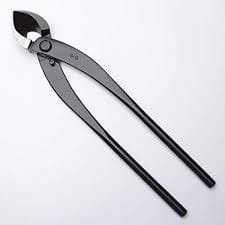
Image Credit: Amazon
Here are some tips and tricks when buying cutting tools:
- For beginners, the basic Japanese bonsai tools you need are shears, root cutter, concave cutter, and knob cutter.
- When buying a concave cutter, the cutting edges should overlap.
- Cutting tools that are made of stainless steel require less maintenance and can resist rust better as compared to carbon steel. However, carbon steel Japanese bonsai tools have a longer-lasting and sharper edge.
Your carbon tools won’t rust as long as you don’t leave them out in the rain, drying them while working, and lightly applying oil now and then. - If you have small bonsai in your collection, avoid buying large shears and pliers. If you want to remove thicker twigs, choose shears with a wide shape. Longer and narrower forms make working dense canopy a lot easier.
- Invest on small shears for your for shohin Bonsai or if you want to trim azaleas and remove their wilted flowers.
- For deepened cuts, use concave cutters having straight blades. You’ll also find concave cutters with knob cutters and semi-round blades.
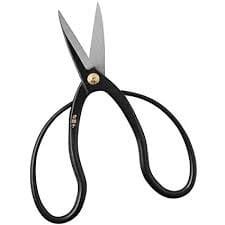
Image Credit: Amazon
Saws and Knives
Saws and knives are used to cut roots, trunks, and branches that are too hard to too thick for a plier. Bear in mind that you need to pull the Japanese pruning saws back to cut.
Avoid pushing them strongly which only results in breaking or bending the blade. You can smooth the wounds and cuts left by saws and pliers using grafting knives. Professional bonsai gardeners usually use a grafting knife.

Image Credit: YouTube
Roots Hooks or Rakes
Root hooks and rakes are available in various sizes, with 1 to 3 teeth. These Japanese bonsai tools are used to open the root ball. They carefully combine the roots and remove the old soil between the roots.

Image Source: eBay
Bonsai Wire and Other Tools for Wiring
At some point, you need to wire your bonsai for training and styling. There are different types of bonsai wire diameters or sizes depending on the size of the branch, twig, or shape of your bonsai.
Small bonsai wires are best shohin Bonsai. A wire perfect for bonsai is made from copper or annealed aluminum. For novice bonsai growers, aluminum wire is better to use than copper because it’s easier to apply.

Image Source: Pinterest
Protective Material and Bending Bonsai Tools
You can bend trunks and branches heavily using protective measures. A protective material is used to prevent breaking the wood and tearing the bark.
It helps fissures and minor cracks to heal without risking the trunk or branch. The traditional method involves wrapping wet raffia tightly around the area to be bent prior to applying the wire. You can fuse a rubber tape or wrap it on the topmost layer of gauze. A bicycle tube is applicable for this purpose.
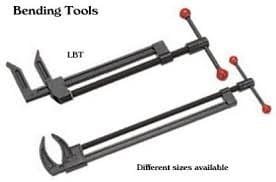
Image Credit: Alibaba
Sieve Sets
Sieve sets are used if you’re using granular soil components, such as pumice, Kanuma, and Akadama. You need to use sieve sets for separating varying grain sizes and removing the smallest and dust particles. You’ll find sieve sets which are made of stainless steel with different mesh sizes intended for this purpose.
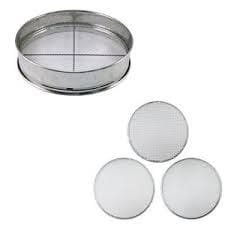
Image Credit: eBay
Other Bonsai Tools You Need
When you’re filling the soil into a bonsai pot, you need to use different sizes of scoops which are shaped when pouring soil below overhanging low branches. You can use push the soil into the cavities between the bonsai and roots using bamboo sticks or chopsticks.
Avoid damaging the roots by not poking it too hard. You’ll need to use a tweezer spatula when removing weeds or to apply moss. These are also useful when pressing wet moss into the soil and excavating persistent or stubborn weeds.
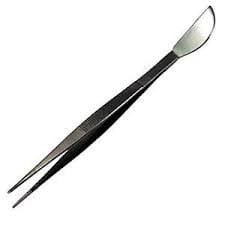
Image Credit: eBay
Tips and Tricks When Using Japanese Bonsai Tools
- Invest in a proper watering can to make sure your bonsai get the right amount of water.
- Most bonsai tools are made of black steel, which requires a bit more maintenance due to rust formation. That’s why it’s important to choose a
- Japanese bonsai tool that is made of premium grade stainless steel.
It’s advisable only to use your Japanese bonsai tools for their intended purpose. Don’t use them for other purposes to avoid ruining them earlier than expected. If you want long-lasting tools and equipment, treat them with care, so you can use them for many years to come.

Image Credit: aliexpress
Conclusion
Choose a Japanese bonsai tool with unmatched reliability and one that can get the job done. Aside from the ones already mentioned, you’ll come across with other bonsai tools as you increase your knowledge and enhance your skills in growing bonsai.

Image Credit: MyBlueprint
